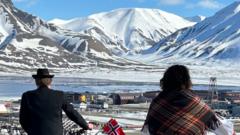In late 2023, Magnus Mæland took office as mayor of Kirkenes, a small town nestled in Norway’s far north. He promptly found himself fielding inquiries from three different Chinese delegations seeking to establish a permanent Arctic presence. “They want to be a polar superpower,” Mæland explains, underscoring China's newfound ambition to position itself in the Arctic realm.
Despite being geographically distant, China is marketing itself as a “near-Arctic state,” albeit its northernmost city, Harbin, lies south of the latitudes typical of the Arctic Circle. This positioning coincides with an unprecedented scramble for Arctic resources, as climate scientists warn that the region is warming at four times the global average. The subsequent melting ice unveils vast reserves of oil, gas, and minerals and opens potential new trade routes—each presenting fresh opportunities for economic gain.
With a strategic vision known as the “Polar Silk Road,” China aims to bolster its maritime trade links through the Arctic. Kirkenes is strategizing to establish itself as a significant European entry point for Chinese shipping, although there are growing concerns about allowing too much foreign influence in local infrastructure.
Terje Jørgensen, Kirkenes' port director, envisions transforming the town into a vital trans-shipment hub uniting North America, Europe, and Asia. He asserts a commitment to maintaining Norwegian control over local commerce, emphasizing protective legislation against foreign acquisitions that could threaten national security.
The Arctic’s geopolitical landscape is further complicated by the burgeoning cooperation between China and Russia. With Russia controlling vast stretches of Arctic territory, the partnership serves both nations as they pursue military and economic interests in the region. However, there remains an underlying tension, as both sides are cautious about relying too heavily on each other—a sentiment echoed by analyst Andreas Østhagen, who highlights that Russia seeks to limit Chinese influence while still courting other global investors.
The darker undercurrents of the Arctic race also reveal local anxieties. In Kirkenes, the war in Ukraine has dampened economic activity, and Norwegian residents remain acutely aware of the proximity to Russian military endeavors. The perceived Russian threat looms large, with suspicions of espionage becoming increasingly common. With NATO strengthening its presence in response, the Arctic's low-hanging fruit of geopolitical interest is ripe for contention.
Meanwhile, the indigenous communities—some of whom have lived in the Arctic for millennia—continue to voice their battles against the encroaching superpowers. Youth activist Miyuki Daorana from Greenland’s Inughuit community stresses that the urgency of the political landscape today starkly contrasts with the dismissive attitudes of the past. The narrative of "green colonialism" emerges, as these communities argue that multinational interests utilize climate change rhetoric to justify the appropriation of their lands and resources.
In their struggles, the indigenous populations express frustration with government rhetoric that neglects their needs, underscoring the dire imbalance between power brokers and those who have historically inhabited the region.
As the Arctic becomes a battleground bordered by conflicting national interests, the traditional narrative of collaborative governance among the Arctic states disintegrates. Indigenous peoples find themselves at the crossroads of a rapidly changing landscape—one where their voices risk being drowned out in the clash of titans.
Despite being geographically distant, China is marketing itself as a “near-Arctic state,” albeit its northernmost city, Harbin, lies south of the latitudes typical of the Arctic Circle. This positioning coincides with an unprecedented scramble for Arctic resources, as climate scientists warn that the region is warming at four times the global average. The subsequent melting ice unveils vast reserves of oil, gas, and minerals and opens potential new trade routes—each presenting fresh opportunities for economic gain.
With a strategic vision known as the “Polar Silk Road,” China aims to bolster its maritime trade links through the Arctic. Kirkenes is strategizing to establish itself as a significant European entry point for Chinese shipping, although there are growing concerns about allowing too much foreign influence in local infrastructure.
Terje Jørgensen, Kirkenes' port director, envisions transforming the town into a vital trans-shipment hub uniting North America, Europe, and Asia. He asserts a commitment to maintaining Norwegian control over local commerce, emphasizing protective legislation against foreign acquisitions that could threaten national security.
The Arctic’s geopolitical landscape is further complicated by the burgeoning cooperation between China and Russia. With Russia controlling vast stretches of Arctic territory, the partnership serves both nations as they pursue military and economic interests in the region. However, there remains an underlying tension, as both sides are cautious about relying too heavily on each other—a sentiment echoed by analyst Andreas Østhagen, who highlights that Russia seeks to limit Chinese influence while still courting other global investors.
The darker undercurrents of the Arctic race also reveal local anxieties. In Kirkenes, the war in Ukraine has dampened economic activity, and Norwegian residents remain acutely aware of the proximity to Russian military endeavors. The perceived Russian threat looms large, with suspicions of espionage becoming increasingly common. With NATO strengthening its presence in response, the Arctic's low-hanging fruit of geopolitical interest is ripe for contention.
Meanwhile, the indigenous communities—some of whom have lived in the Arctic for millennia—continue to voice their battles against the encroaching superpowers. Youth activist Miyuki Daorana from Greenland’s Inughuit community stresses that the urgency of the political landscape today starkly contrasts with the dismissive attitudes of the past. The narrative of "green colonialism" emerges, as these communities argue that multinational interests utilize climate change rhetoric to justify the appropriation of their lands and resources.
In their struggles, the indigenous populations express frustration with government rhetoric that neglects their needs, underscoring the dire imbalance between power brokers and those who have historically inhabited the region.
As the Arctic becomes a battleground bordered by conflicting national interests, the traditional narrative of collaborative governance among the Arctic states disintegrates. Indigenous peoples find themselves at the crossroads of a rapidly changing landscape—one where their voices risk being drowned out in the clash of titans.




















